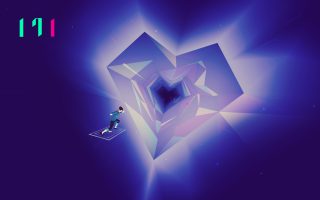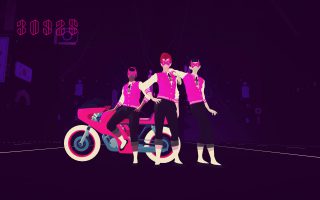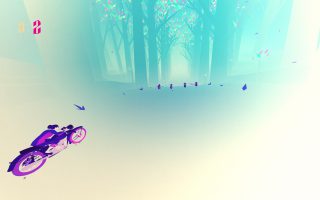Sayonara Wild Hearts Review
Wild Hearts Never Die
I can almost pinpoint the exact moment when Sayonara Wild Hearts captured my heart. It was during the E3 2018 Nintendo Direct, I was immediately charmed by the short trailer shown. It showcased the game’s brilliant art style which is beautiful, distinct, and bold while having fluid animations and cohesion despite the multitude of distinct levels and mechanics that propel players through this experiential album. But a trailer can only tell so much about a game, especially one like Sayonara Wild Hearts.
In the most basic of terms, the game is a combination of Rez and Audiosurf, with so many other influences and homages that it would be ridiculous to list them all. You rocket down city streets and forest pathways to a pop album, breaking hearts and learning to love again. The game constantly builds on and changes the way the player interacts with the world in intelligent and fluid ways which never require a tutorial. The first time I booted up the game I was a little inebriated from a work party, and had zero troubles immediately grasping what the game wanted me to do. Since the controls are so simple nearly anyone can pick up and play.
The artwork is nice in screenshots but stunning in motion. The deep hues that make up the many locales serve as a brilliant backdrop to the high-speed chases of the game. Careening down the purple alleyways of Hatehell Valley in pursuit of the very stylish Dancing Devils biker gang is the moment when the game truly demonstrates what it’s capable of, even though it only just begins to scratch the surface of where and what the game will become.
The songs range from around 45 seconds up to 8 minutes, which also happens to tell you how long the levels are. The strongest tracks are the full songs – in contrast to the instrumental tracks – but each fits perfectly with the world and tone of the game. They range from super upbeat to more mellow or brooding tracks. The closest comparison that came to my mind is Chvrches, but everyone will find their own touchstone to compare it to. The vocals by Linnea Olsson are evocative and powerful. It’s a shame her voice isn’t on even more of the tracks in the game, as she is mostly reserved for the Thumper-like boss battles.
Unlike many rhythm games, you’re able to pay attention to what is happening on the screen in front of you since you aren’t pushing specific  buttons, nor are you required to hit a certain score threshold to advance. You can instead focus on being absorbed by the whole experience, and it will require your full attention at times. You aren’t exactly playing along to the music; the game is more like a music video, with occasional instances where you will have quick-time events paired with the beat. This ensures that the action on the screen always syncs up with what you’re doing and you get the perfect effect every time.
buttons, nor are you required to hit a certain score threshold to advance. You can instead focus on being absorbed by the whole experience, and it will require your full attention at times. You aren’t exactly playing along to the music; the game is more like a music video, with occasional instances where you will have quick-time events paired with the beat. This ensures that the action on the screen always syncs up with what you’re doing and you get the perfect effect every time.
While there are no hard fail states that require you to restart a song, you can still be sent back a few seconds if you crash into a wall or other obstacle (the music will also roll back to stay synced with your progression through the level). The game does this quickly and offers you the ability to skip past sections that are causing you trouble if you would rather just continue with the experience. It’s a nice concession to help people who may struggle to keep up with the frenetic pace of the game. The downside to the soft reset is it also resets your score bonus.
 Chasing high scores in Sayonara Wild Hearts seems to be at odds with the way the game wants to be played. On one hand, it’s a great excuse to return to the game and play it over and over to perfect runs. But on the other, in some instances, it requires you to take a specific path through the level. This ends up feeling more like a chore as your trial and error your way through the multiple pathways the game puts in front of you. Take the wrong path and you’ve possibly ruined your run because you’ve missed some high scoring collectibles. I’d much rather take what feels like the natural path than try to thread the needle between a streetcar and tunnel wall, just to pick up a single collectible. It’s a small complaint, and I’m more than happy to play these levels over and over because they all offer something a little different to keep you on your toes. Getting a gold rank on every level in the game will unlock a bonus, but the arcade mode you unlock after finishing the game once should be more than enough for most people.
Chasing high scores in Sayonara Wild Hearts seems to be at odds with the way the game wants to be played. On one hand, it’s a great excuse to return to the game and play it over and over to perfect runs. But on the other, in some instances, it requires you to take a specific path through the level. This ends up feeling more like a chore as your trial and error your way through the multiple pathways the game puts in front of you. Take the wrong path and you’ve possibly ruined your run because you’ve missed some high scoring collectibles. I’d much rather take what feels like the natural path than try to thread the needle between a streetcar and tunnel wall, just to pick up a single collectible. It’s a small complaint, and I’m more than happy to play these levels over and over because they all offer something a little different to keep you on your toes. Getting a gold rank on every level in the game will unlock a bonus, but the arcade mode you unlock after finishing the game once should be more than enough for most people.
In fact, the arcade mode should have been the main mode for the game, as being sent back to the level select after each song pulled me out of the experience too often. The level select screen also has the tracks for every song, and choosing a song at the opposite end of the tracklist will require you to pass every single song in the game. A way to quickly navigate between themed sections would be nice, but these are just nitpicky things.
The game also features 24 zodiac riddles for players to solve. They really are riddles, that just barely  hint at what the game wants you to complete. So far, in my three complete playthroughs of the game, I’ve only managed to complete one of the riddles. You’re free to totally ignore them, or dive deep and try to uncover all of the games hidden secrets.
hint at what the game wants you to complete. So far, in my three complete playthroughs of the game, I’ve only managed to complete one of the riddles. You’re free to totally ignore them, or dive deep and try to uncover all of the games hidden secrets.
Sayonara Wild Hearts delivers great pop music paired with a game that truly feels like it was meant to be paired with it. The music and gameplay feel so linked together that listening to the soundtrack outside of the game will immediately bring you back to flying and sword fighting biker gangs no matter where you are. It’s a wild ride which needs to be experienced to be fully appreciated.
Pros
- Fantastic soundtrack
- Stunning visuals
- Constantly shifting gameplay
- Very replayable
- Easy to pick up
Cons
- Not enough songs with vocals
- High score hunting feels at odds with the core experience
